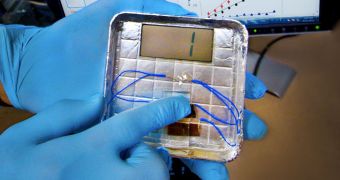Being able to recharge your mobile devices as you do everyday tasks is something that was recently brought closer to reality by experts at the US Department of Energy's (DOE) Lawrence Berkeley National Laboratory (Berkeley Lab).
Scientists here announce the creation of an electricity generator that uses harmless viruses and a property of certain ceramic and crystal materials, called piezoelectricity, to produce current. The paper-thin instrument can be outfitted, for example, in the soles of shoes.
A thin wire woven through the fabric of pants could lead up to the pocket, where a small dock would connect to your mobile phone. Every time you stepped, a small amount of energy would be passed into the device.
Piezoelectricity is the property some crystals and ceramics have, of producing an electrical current when mechanically deformed by an exterior force. The opposite is also true – applying a current on these materials changes their shape.
The most amazing aspect of this research, and the thing that makes it different from every other study of this type, is that instead of using the piezoelectric properties of standard materials, it uses the same property in viruses. This is the first time a biological piezoelectric material is used in this manner.
At this point, the generator works by tapping your finger on a small, postage stamp-sized electrode, which is covered in these specially engineered viruses. This achievement is remarkable, since it could lead to the creation of devices that harness energy from vibrations and motions.
This means that generators could produce electricity when you shut a door, walk, when a car breaks, when wind blows past an electrode at sufficiently high speeds, when you clap your hands and so on.
In addition, the Berkeley Lab team explains, the new class of biological piezoelectric generators could enable the development of next-generation microelectronic devices. The latter could be of great use for experts working in the field of nanotechnology.
Details of the research effort were published in the May 13 advance online issue of the top scientific journal Nature Nanotechnology.
“More research is needed, but our work is a promising first step toward the development of personal power generators, actuators for use in nano-devices, and other devices based on viral electronics,” investigator Seung-Wuk Lee explains.
The expert holds an appointment as a faculty scientist with the Berkeley Lab Physical Biosciences Division. He is also an associate professor of bioengineering at the University of California in Berkeley.

 14 DAY TRIAL //
14 DAY TRIAL //